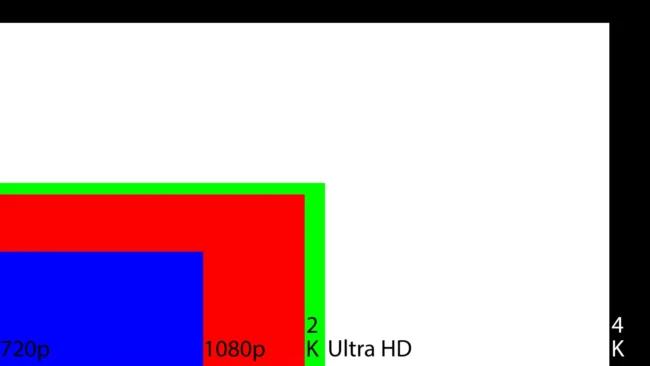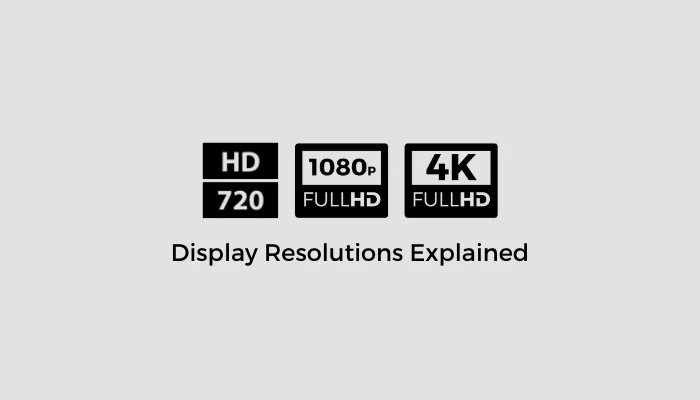The screen resolution is a number that shows the number of rows and columns in pixels. For smartphones, it might be 5″ or 50″ but it doesn’t matter too much because they’re always round numbers.
In this guide, we have addressed some of the most common misconceptions and questions related to digital display resolutions. For example, below are some commonly asked questions:
-
The biggest difference between 2K and 4K screens is the total number of pixels. In short, a 4K screen will have four times as many pixels as a 2K screen.
-
The difference between qHD and QHD is resolution. QHD TV has higher resolution than qHD TV.
-
Is 2K twice the size of 4K?
-
Is 1080p 1K?
-
What are the different resolutions and what do they actually mean?
If you had any of the above questions, we have tried to answer all of them here and some more as well.
What is Screen Resolution?
Resolution is the number of pixels on a display or screen. The resolution of a screen is determined by the number of pixels it has. Resolution is measured in pixels per inch. The more details or ‘pixel density’, the sharper an image appears. For instance, things often appear pixelated on older monitors. But interestingly, only having a higher resolution does not make for a great display. There are other factors, such as dynamic range & color reproduction, which also determine the quality of the display

Here’s some quick, handy guide for the most common display resolutions:
Resolution Pixels 540p / qHD 960×540 pixels 720p / HD 1280×720 pixels 1080p / Full HD / FHD 19201080 pixels 2K 2048×1080 pixels 1440p / QHD / QuadHD / WQHD 2560×1440 pixels 2160p / UHD 3840×2160 pixels 4K 4096×2160 pixels 5K 5120×2880 pixels 8K / 8K UHD 7680×4320 pixels
540p / qHD
qHD is actually 1/4th of the HD resolution. By today’s standards, even an HD resolution is considered as very bad. It has 4 times fewer pixels than a 1080p display resolution. The typical qHD resolution is 960 x 540 pixels. It is also called as 540p.
720p / HD
HD is the most misused marketing term on the planet. You see a lot of resolutions named qHD, QuadHD, QHD, FHD, and Ultra HD. HD, short of High Definition, is often associated to anything that is marketed as higher quality. For now, let’s see what the ‘HD’ actually means.
1280 x 720 pixels is the HD Resolution. It is more commonly referred to as 720p.
1080p / Full HD / FHD
1920 x 1080 pixels is the Full HD Resolution. It is also called as FHD and 1080p. 1080p displays pack over 2 million pixels which is about twice as much of the “HD” resolution.
2K is NOT QHD and vice versa.
2K
2K refers to a resolution where the larger of the pixel measurements is over 2000 pixels. A typical 2K resolution is 2048 × 1080 pixels. Basically it’s a 1080p display with a wider aspect ratio. 2K is therefore not quite the same as QHD, and in fact, QHD is better. But QHD is often confused with 2K resolution.
1440p / QHD / QuadHD / WQHD
2560 x 1440 pixels is the QuadHD resolution. 1440p resolution contains 2 times the pixels of the “HD” resolution (which is 4 million pixels) and hence the name “QuadHD”. All of the above-mentioned names refer to the same screen resolution.
The QHD also has an aspect ratio of 16:9 which is considered wide and hence some manufacturers choose to put the “W” in front of it to indicate it is WIDE, making it the “WQHD”.
2160p / UHD
UHD features a 16:9 aspect ratio and is twice the resolution of full HD. In other words, two times 1080p, two times 1920 x 1080 pixels, that is 3840 x 2160 pixels. Having the same 16:9 aspect ratio means it is backward compatible with other HD derivates. However, both 4K and UHD can be shortened to 2160p to match the HD standard and therefore, companies use the terms interchangeably.
4K
If you think 4K and UHD are the same, I don’t blame you. I blame the companies that love to use them interchangeably all the time. Although 4K is not widely used among consumers yet, 4K displays are much more common in professional settings due to their ability to support much higher resolutions. For example, digital cinemas and other display screens for professionals use 4K displays which can support resolutions of 4096 x 2160 pixels.
5K
The 5K display standard is not widely used. The only devices I’m aware of that use it are Apple’s 27-inch iMac displays, which have a resolution of 5120 x 2880 pixels. A lot of new monitors have this resolution, including the 27-inch Ultrafine 5K monitor.
8K / 8K UHD
7680 x 4320 pixels is the resolution for 8K. As for 8K UHD resolution displays, they have an aspect ratio of 16:9. All digital displays or images with a width or higher pixel value of approximately 8000 pixels have an 8K resolution. With this level of resolution, the naked human eye will not be able to see any pixels at all and the display will look very clear as no dots are visible.
Display Resolutions and Use Cases
Below are a few use cases of the resolutions:
Resolution name Other names Devices 8K 8K UHD TVs “Cinema” 4K 4K Projectors UHD 4K, Ultra HD, Ultra-High Definition TVs, monitors, smartphones 2K none Projectors WUXGA Widescreen Ultra Extended Graphics Array Monitors, projectors 1080p Full HD, FHD, HD, High Definition TVs, monitors, smartphones 720p HD, High Definition TVs, Smartphones
The below image should give you an idea of how much bigger a 27-inch monitor is than a 13-inch laptop.
This article has taught you about the different display resolutions and terminologies available for TVs, monitors, laptops etc.


COMMENTS